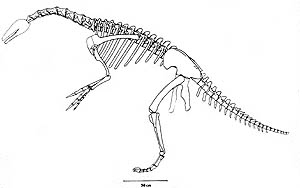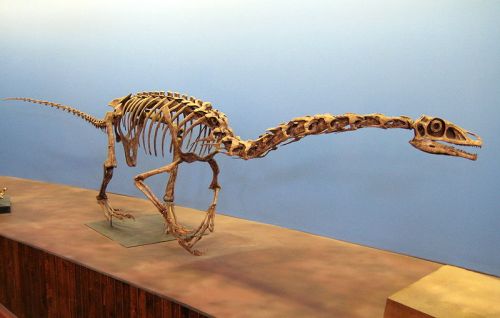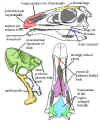 Alxasaurus = Alxasauridae)
Alxasaurus = Alxasauridae)| Coelurosauria | ||
| The Vertebrates | Therizinosauria |
| Vertebrates Home | Vertebrate | Vertebrate |
|
Abbreviated Dendrogram
Dinosauria
├─Ornithischia
└─┬─Sauropodomorpha
└─Theropoda
│
└─Coelurosauria
├─Tyrannosauroidea
└─┬─Ornithomimosauria
└─┬─Maniraptora
├─Therizinosauria
│ ├─Falcarius
│ └─Therizinosauroidea
│ ├─Beipiaosaurus
│ └─┬─Alxasaurus
│ └─Therizinosauridae
└─Metornithes
├─Alvarezsauridae
└─┬─Oviraptorosauria
└─Paraves
├─┬─Troodontidae
│ └─Dromaeosauridae
└─Aves
|
Contents
Index |
Therizinosauria. Falcarius
Synonyms: Segnosauria Barsbold & Perle 1980, Segnosaurischia Dong 1992, Therizinosauridae Sereno 1998
Phylogenetic Definition: The most inclusive clade containing Therizinosaurus cheloniformis but not Tyrannosaurus rex, Ornithomimus edmontonicus, Mononykus olecranus, Oviraptor philoceratops or Troodon formosus (stem-based) (Zanno 2010)
Range: Cretaceous of NAm & East Asia
Phylogeny: Maniraptora : Metornithes + * : Falcarius + Therizinosauroidea).

Horizon: Lower Yellow Cat member of the Cedar Mountain Formation (Barremian), Utah
Phylogeny: Stem Therizinosauria.
Comment: Known from over 3000 complete or partial elements have been collected from the holotype locality, representing a mass death assemblage of hundreds of individuals in various growth stages, which makes Falcarius the most complete therizinosaurian yet found (Zanno 2010). A lightly built animal about 4 meters long, with a long neck and small head; unusually for theriznosaurs, the tail is very long The most primitive and ancestral therizinosaur yet known, it reveals the transition from primitive carnivory (a long-bodied small-headed, rather typical coelurosaur, think Coelurus or Ornitholestses) to herbivory (in this instance, the upright, short-tailed, ground sloth-like therizinosaurs).
Image: Falcarius utahensis, Utah Museum of Natural History. Photo by Paul Fisk, via Wikipedia, Creative Commons Share Alike
Links: Falcarius: bizarre sickle-cutter - Scott Hartman; Falcarius, Killer Dinos Turned Vegetarian - Utah Geological Survey; Dinosaur embraced vegetarianism : Nature News; Falcarius - Wikipedia MAK120307
Therizinosauroidea(=Segnosauria)
Range: Early Cretaceous (Barremian) - Late Cretaceous (Maastrichian) of China & North America.
Phylogeny: Therizinosauria : Falcarius + * : Beipiaosaurus + (Alxasaurus + Therizinosauridae).
Characters: 2-8 m long, <100-2000 kg; head unusually small; ant jaws toothless and form bill structure; teeth small, se , slightly flattened and ($) bulbous; braincase and vertebrae pneumatized; neck long and light; $ cervicals elongate (?) and highly pneumatized, with ($) widely-spaced zygapophyses; anterior dorsal vertebrae with tall neural arches; dorsal ribs flat & broad; 5-6 sacrals; tail somewhat short, anteriorly massive; scapula strap-like; large coracoid; forelimbs elongated; humerus massive with expanded ends in some spp; conspicuous, sharply peaked deltopectoral crest posteromedially on humerus (not all spp); manus variable, but generally large and bearing long claws, curved or uncurved; $ very broad pelvis; ilia widely separated; ilia very deep above acetabulum and flare laterally; post-acetabular ilia are short, with unique knob-like protruberances; pubes retroverted (i.e. opisthopubic); tibia 80%+ length of femur; fibula slender & closely appresed to tibia; $ short metatarsus (<1/3rd length of tibia); broad, short, ($) 4-toed feet; foot claws (unguals) pointed, curved and laterally compressed; proximal end of 1st metatarsus reaches tarsus (?). Possible herbivores, and general form converges on prosauropods.
Links: DD: Therizinosauridae; Literature - Segnosauria; DIM - number 12; A therizinosauroid dinosaur with integumentary structures from China; Untitled Document; DGF, Geological Society of Denmark, Geologisk Tidsskrift Nr. 4, 1996.
Note: possibly originated in Central Asia. 010619.
Discussion: Greg Paul's reconstruction shows visually how weird these creatures truly were -- so odd that for some years they were thought to be a Cretaceous relict of an early prosauropod lineage. In many ways, the Therizinosaurs do resemble some aberrant sauropodomorph. In other ways they are just as clearly Theropods. The head best illustrates this mixture. The skull is small, although not any smaller than that of reasonably close relatives, such as the Ornithomimosaurs. The front of the snout is usually curved downward. The front of the jaw is sometimes described as "bill-like," but there is little in the way of lateral expansion. Perhaps it is more like the offset jaw articulation of prosauropods -- designed to create a moving point of contact rather than single tearing force as in carnosaurs. The front of the jaw lacks teeth, which is a bit hard to explain. However, we have little idea what "soft" keratinous structures might have been present, such as a sharp tearing beak. The teeth, especially those in front, are somewhat chisel-like with a constricted base. This might be interpreted as the beginnings of a convergence toward the leaf-shaped teeth of sauropods. The teeth are also very numerous, recalling the beginnings of Ornithischian dentition, and are supplemented by sharp, curved denticles. This would be hazardous duty for a tongue! The back teeth are of a more indeterminate small-theropod grade. On the whole, the back teeth seem designed to cut or hold, while the front teeth sheared and the beak, if any, cut -- a real chimera.
The head is highly pneumatized and mounted on neck vertebrae which were also full of air holes. However the neck differs markedly from sauropods in that it is not heavily reinforced and was probably quite mobile. There are no exaggerated zygapophyses, interlocking caudal ribs or ossified tendons which would have held the neck rigid. The individual vertebrae are not elongated. These features suggest a relatively vertical posture, because there is no obvious way to hold the neck horizontally without continual muscular effort.
This impression is confirmed by the angled pelvis and general back-heaviness of the body. The arms are relatively slender, but long and probably heavily muscled. Both the large coracoids and the marked deltopectoral crest on the humerus suggest this, as do the enlarged ends of the arm bones. In fact, the thin central shaft of the humerus is the most difficult part of the arm to explain: perhaps a savings in weight at the expense of tensile strength. The enormous claws, particularly of Therizinosaurus, are also difficult to interpret. They seem almost too large for digging, and in Alxesaurus they are only slightly curved, a feature which would preclude digging against ordinary earth. One might speculate that these animals lived in a more arid, sand-dominated environment. Alternatively, the claws may have been specialized to strip bark or fronds from some locally common type of vegetation.
The pelvis is equally strange: enormously deep and wide, solidly fused to 5 or 6 vertebrae. The leg proportions tell us that this was no runner. Yet the pelvis would permit the attachment of huge leg, and possibly tail, muscles. The reversed pubic bones suggest additional room for the typical herbivore gut. However, as Paul has illustrated, a large gut hangs almost to the ground in the anticipated semi-vertical posture. At the same time, Therizinosaurs seem to have the classic dinosaur perforated acetabulum (the socket in the pelvis where the leg fits) with the back legs originating fairly close to the mid-line. Frankly, it is almost impossible to see how this arrangement of parts would fit together. Paul solves the problem by angling the femur about 20 degrees out from the mid-line. This leaves the femoral head at a reasonable place and angle to fit in the socket, but gives the animal an absolutely bizarre gait, something like a sumo wrestler -- very stable but not at all graceful. The feet are blocky and short, with an unusual 4 digits: not the usual sort of digging leg, which is longer. However, the probable short, curved claws would make good digging tools.
One possible reconstruction is, again, that Therizinosaurs were essentially desert animals. The gait, large, square feet and very low center of gravity all contribute to generate great stability on uncertain, shifting surfaces. Additional balancing adaptations might be the long mobile arms, as well as the relatively large brain. The bulbous body shape minimizes surface area. The hands and feet might be capable tools for digging in loose or sandy soil for roots, for extracting small lizards or mammals, or for splitting the tough exterior of typical desert plants while avoiding any sharp protective spines or scales. The relatively short tail reflects that tails are a less adequate method of achieving balance in a more-or-less upright posture, since the tail's reduced horizontal distance from the center of gravity also reduces the effect of torque. The small gastroliths found in the gut of some therizinosaurs might evolve simply from the necessity of doing something with the sand and gravel inevitably eaten with a diet of roots or burrowing desert animals. Undoubtedly, there are other plausible reconstructions, but it is interesting to imagine a small group of therizinosaurs plodding slowly over a dune near sunrise, their crested heads lurching and darting about, perhaps covered in white feathers to reflect the sun, stopping occasionally to dig up roots or excavate the burrows of unlucky mammals, making their endless rounds of widely scattered or seasonal oases. ATW 010619.
Note added in Disproof: Russell & Dong (1993) note that there is an "association between therizinosaurids and relatively moist (fluvial and lacustrine) environment Asia." This generalization may hold up with Beipiaosaurus as well, since this early therizinosauroid was found in the notably lake-dominated Yixian. Xu et al. (1999). So its back to the drawing board on the ecological restoration in this Note, although the mechanical analysis still seems to hold up.
References: Currie (2000), Russell & Dong (1993); Xu et al. (1999).
Range: Early Cretaceous (Barremian) of China.
Phylogeny: Therizinosauroidea: Alxasaurus + Therizinosauridae) + *.
Characters: ~2 m; $ largest skull of Therizinosauroidea and ($) shortest, most bulbous tooth crowns; >37 teeth, with dorsally pointed, triangular interdental plates; cervical vertebrae with small, short spines; "fused posterior dorsals" (= pygostyle?); furcula widely arched; hpocleidium absent; semilunate distal carpal present; long hand (10% longer than femur); several features of hand said to be same as Deinonychus; manual unguals laterally comperssed & strongly curved; ilium with shallow anterior iliac process (similar to that of dromaeosaurs?); posterior andanterior processes of ilium equal; hindlimb short & stout; crest on the tibia; medial surface of fibula flat, without medial fossa; metatarsals III & IV compressed proximally; Mt V slender & strap-like; feet with three functional toes and splint-like proximal 1st metatarsal; integument with "proto-feather" filaments 5-7 cm in association with limbs; filaments contact bones; Xu et al. report possibly hollow and branching at ends.
Links: DD: BEIPIAOSAURUS inexpectus; DIM - number 1; theropode.pdf; Beipiaosaurus -- The Dinosauricon; Beipiaosaurus; Beipiaosaurus Dutch); Dann Pigdon's Paleo Gallery @ Prehistorics Illustrated page 07; Dinosauria Translation and Pronunciation Guide B; Nieuwe therizinosauride (Dutch); Untitled; New feathered dinosaur found; Beipiaosaurus Fact Sheet - EnchantedLearning.com; *Beipiaosaurus* Recapitulated; A therizinosauroid dinosaur with integumentary structures from China.
References: Xu et al. (1999).
 Alxasaurus = Alxasauridae)
Alxasaurus = Alxasauridae)
Range: mid-Cretaceous (Albian) of China.
Phylogeny: Therizinosauroidea:: Therizinosauridae + *.
Characters: 4 m; 380 kg; >40 very small teeth on dentary; teeth extend to front of jaw; interdental plates probably present; cervical neural spines small & narrow; zygapophyseal articulations broad; centra amphiplatyan; cervical ribs not fused; 5 sacral vertebrae; short tail, but 13 caudal vertebrae with transverse processes; scapular blade very long and slender with little distal expansion; coracoid probably circular; arms slender & very long; relatively small deltopectoral crest on humerus; ~70 cm manual unguals; elongate ilium with moderate preacetabular expansion; femoral shaft slightly bowed; large, keeled "posterior" (prob. = greater) trochanter separated by cleft from "anterior" (lesser) trochanter; 4 functional toes.
Links: DD Alxasaurus; Alxasaurus Printout- ZoomDinosaurs.com; Alxasaurus -- The Dinosauricon; Alxasaurus; PANGEA Italian); DinoDictionary.com | A - Dinosaurs Page 2.
References: Currie (2000); Russell & Dong (1993).
Image: Alxasaurus reconstruction from Russell & Dong (1993).
Note: Russell & Dong diagnose Alxasaurus and the Alxasauridae by a number of features. However these are, as they state, almost certainly plesiomorphic. Thus, it may not be wise to recognize a separate family at this point based on a diagnosis which will almost certainly take in a paraphyletic group of stem therizinosauroids. 010619.
 Therizinosauridae: Erlikosaurus, Segnosaurus, Therizinosaurus.
Therizinosauridae: Erlikosaurus, Segnosaurus, Therizinosaurus.
Range: Late Cretaceous (Cenomanian - Maastrichian) of China, Mongolia, & Central Asia.
Phylogeny: Therizinosauroidea:: Alxasaurus + *.
Characters: Larger therizinosauroids. Skull & jaw shallow & long; teeth absent from front of jaws; jaw curves downward in anterior; dentary shallow, with weak coronoid process; external mandibular foramen large; palate highly vaulted; long, posteriorly shifted vomers & palatines; vomers fused (?), forming vertical plate; pterygoids reduced rostrally; probable beak on premaxilla; external nares very long, with long nasal process of premaxilla; frontal very large dorsally; basicranium & otic region enlarged & highly pneumatized; cervical ribs fused to vertebrae; 6 sacral vertebrae with long transverse processes and ribs; humerus with both ends strongly expanded; long, massive deltopectoral crest; ligament pits on phalanges shallow; opisthopubic; ilium short with significant preacetabular expansion; postacetabular process very short, with knob-like caudolateral protruberance; femoral head turns at right angle with distinct neck; greater trochanter expanded and separated from lesser by cleft; 4th trochanter present as rugose crest; long ascending process of astragalus; astragalus with reduced condyles, only partly covering distal end of tibia; foot claws large, narrow, & curved.
Links: DD: Therizinosauridae; Question of Segnosaurs; Therizinosaurids; Segnosaurus Dutch).
References: Barsbold & Maryanska (1990); Currie 2000).
Image: skull and palate of Erlikosaurus, pelvis of Segnosaurus. Both modified from Barsbold & Maryanska (1990).
Note: some of the characters above are from Barsbold & Maryanska (1990) based on materials even more skimpy than those known today. 010618.
checkedATW040810, revised MAK120307